Featured Articles
Seth Abraham: Floyd Is His Own Best and Worst Advisor

 “Money” arrives in Vegas on Tuesday; as always, he generates debates and emotions in fight fans, and vast amounts of copy from writers who remain fixated on what makes him tick, and why he doesn't seem so keen on making a fight all boxing fans want to see.
“Money” arrives in Vegas on Tuesday; as always, he generates debates and emotions in fight fans, and vast amounts of copy from writers who remain fixated on what makes him tick, and why he doesn't seem so keen on making a fight all boxing fans want to see.
A Twitter friend asked me on Tuesday why I continue to perseverate on The Fight when it is obviously dead on pre-arrival.
A good question, I had to give it to him.
Why indeed write about a Mayweather-Pacquiao fight when Mayweather is set to fight in a real-deal scrap, not a theoretical one, in just a few days. That excellent and pointed query got me thinking: why am I spending time and energy writing about Mayweather-Pacquiao when Mayweather-Cotto is at hand?
Here's why: because it's a mystery, and I like mysteries, and am an intellectually curious soul who is often moved to try and solve mysteries, or at least make enough sense of them so they don't stay lodged in my brain, bugging me. Yeah, this one bugs me. I just don't get it. And I'm not inclined to shrug it off, and move on. You can call that persistent, or mule-ishly stubborn. Why can't the parties involved give the fans what they want, what they've wanted for a few years?
Now, it can be argued that this is a business, and the customer isn't always right, so to hell with the customers. Believe me, boxing fans are quite used to this line of thinking. But, if the fans do not matter all that much, shouldn't the money matter? Shouldn't the fact that about a quarter billion dollars be grossed from this superfight spur the involved parties to get it done? One would think…but since conventional wisdom hasn't been adhered to, and a no-brainer of a fight hasn't been made, we are left to wonder why. I ponder it on a daily basis, right or wrong, because I have a fundamental dislike for situation where rationality is tossed out the window. I spend too much time why voters vote for politicians who craft and adhere to policies which leave them poorer on a daily if not hourly basis, and why The Fight hasn't been made almost as often.
So…forgive my long winded prologue to part two of my discussion with ex HBO boxing chief Seth Abraham, who I had the pleasure of chatting with a short time ago. He now runs a consulting shop, Starship, and teaches part-time.
Abraham told me he thinks Mayweather-Pacquiao won't happen–“The percentage chance of the fight happening, today, is zero”–and it's not because of money.
At various times, I've thought that it is about “Money,” that Floyd's pride won't let him be party to a situation which will enrich Pacquiao, who has a lawsuit against Mayweather, for defamation, pending. I mean, wouldn't you think that Floyd could get past his enmity for the Filipino if it were to mean he'd net double or triple the amount he's ever made for a fight? I would…But Abraham says money isn't the sticking point.
“I believe it's not about money,” Abraham told me. “I don't think it has anything to do with blood work or money. Both fighters would make vast sums.” No, the ex HBO head thinks that Floyd is more concerned with legacy, not money. He wants to be lumped in with the Sugars and Ali, as an all-time fight god, and he thinks that retiring undefeated will go a long way in helping that legacy be achieved. (He's probably right…as years pass, fewer and fewer folks would be inclined to dig down on Floyd's record, and examine if in fact he fought the best and brightest of his era, when they were freshest and most dangerous, or not. They would and will reach for the most tantalizing, low-hanging fruit of statistic: that zero. That lack of a loss. That will speak louder and louder as the decades pass, IMO.)
Abraham told me that back in 2000, when HBO was trying to nail down an extension with Floyd–he'd been making about $800,000 a fight, and the new deal would pay him about $4 million per bout–he tried to argue that fighting and beating the best was more important for his legacy than that “0.”
“He didn't buy it,” Abraham said.
Furthermore, Abraham said if Pacquiao loses, to Tim Bradley, then The Fight for sure doesn't happen. “Then Floyd feels vindicated. He will fight you, me and Larry Merchant. He'll get as many victories as he can.”
Regularly, fight fans or even casual sports fans will ask me if Floyd is smart, or dumb. I tell them he is not dumb, for sure. Now, can he be ignorant, and insensitive and engage in speech and behaviors that suggest he has racist tendencies? Just look at his recent history, on Ustream, and the fact that he seems casually use language that many would term hurtful, words which play up differences in sexuality or ethnicity. Would some folks determine that anyone that fixates so much on money, and seems to believe that net worth equates to self worth and indicates a certain status in society is “stupid?” They would; but I don't think “stupid” is the correct designation at all. Abraham agrees: “Floyd is very much his own man. He has his advisors. But Floyd is his own man, for better or worse.”
The man who spent hundreds if not thousands of hours doing deals with Don King and Bob Arum at their apex in the 80s and 90s does think that advisors will lobby Floyd to make The Fight. (Remember, while wealth hasn't trickled down to the masses in the last 40 years in America, we can assume dough from The Fight would enrich members of the Mayweather and Pacquiao teams, so if you are rooting for The Fight to happen, I guess you have to hope that Al Haymon holds more sway over Floyd than some think he does.) Back in 2000, Abraham sat in his office in NY with Floyd and Arum, then his promoter. He pre-arranged with Arum to get the promoter to step out of the meeting, when things bogged down. Abraham said he asked Floyd why he wouldn't sign a deal that would increase his purses almost five times.
“He couldn't come up with a reasonable explanation,” Abraham said. “That told me he is his best and worst advisor. He is a great, great talent in the ring. But I don't know why he doesn't listen more to his advisors.”
I'd offer that maybe it is because, historically, advisors are quite often in it to enrich themselves first and foremost, and do not actually give a tinker's damn about the boxer they represent. So…maybe this indicates that Floyd is actually far smarter and craftier than most if not all pundits have given him credit for.
Well, I could go on for another few thousand words. I'm quite sure that in the very near future, I will delve into elements of The Fight Seth Abraham Thinks Will Not Happen we didn't touch on, like, just what the heck is it about Pacquiao, and his style, or his training regimen, which puts the fear of the legacy-smearing loss in Mayweather, in depth. I leave you, if you are tired of pondering the issue, with a muted apology, and if you still hunger to see The Fight, a promise to keep on examining the matter, helping if at all possible to shed light on the subject, and in some small way, helping push the event towards fruition.
Follow Woods on Twitter here.
Featured Articles
Bombs Away in Las Vegas where Inoue and Espinoza Scored Smashing Triumphs
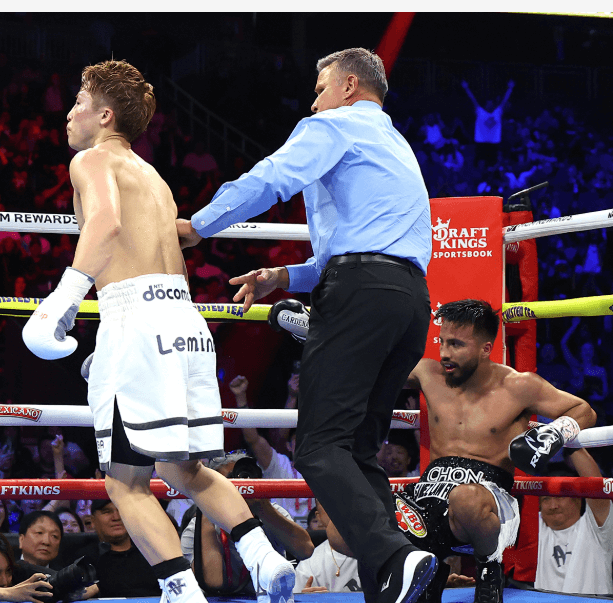
Japan’s Naoya “Monster” Inoue banged it out with Mexico’s Ramon Cardenas, survived an early knockdown and pounded out a stoppage win to retain the undisputed super bantamweight world championship on Sunday.
Japan and Mexico delivered for boxing fans again after American stars failed in back-to-back days.
“By watching tonight’s fight, everyone is well aware that I like to brawl,” Inoue said.
Inoue (30-0, 27 KOs), and Cardenas (26-2, 14 KOs) and his wicked left hook, showed the world and 8,474 fans at T-Mobile Arena in Las Vegas that prizefighting is about punching, not running.
After massive exposure for three days of fights that began in New York City, then moved to Riyadh, Saudi Arabia and then to Nevada, it was the casino capital of the world that delivered what most boxing fans appreciate- pure unadulterated action fights.
Monster Inoue immediately went to work as soon as the opening bell rang with a consistent attack on Cardenas, who very few people knew anything about.
One thing promised by Cardenas’ trainer Joel Diaz was that his fighter “can crack.”
Cardenas proved his trainer’s words truthful when he caught Inoue after a short violent exchange with a short left hook and down went the Japanese champion on his back. The crowd was shocked to its toes.
“I was very surprised,” said Inoue about getting dropped. ““In the first round, I felt I had good distance. It got loose in the second round. From then on, I made sure to not take that punch again.”
Inoue had no trouble getting up, but he did have trouble avoiding some of Cardenas massive blows delivered with evil intentions. Though Inoue did not go down again, a look of total astonishment blanketed his face.
A real fight was happening.
Cardenas, who resembles actor Andy Garcia, was never overly aggressive but kept that left hook of his cocked and ready to launch whenever he saw the moment. There were many moments against the hyper-aggressive Inoue.
Both fighters pack power and both looked to find the right moment. But after Inoue was knocked down by the left hook counter, he discovered a way to eliminate that weapon from Cardenas. Still, the Texas-based fighter had a strong right too.
In the sixth round Inoue opened up with one of his lightning combinations responsible for 10 consecutive knockout wins. Cardenas backed against the ropes and Inoue blasted away with blow after blow. Then suddenly, Cardenas turned Inoue around and had him on the ropes as the Mexican fighter unloaded nasty combinations to the body and head. Fans roared their approval.
“I dreamed about fighting in front of thousands of people in Las Vegas,” said Cardenas. “So, I came to give everything.”
Inoue looked a little surprised and had a slight Mona Lisa grin across his face. In the seventh round, the Japanese four-division world champion seemed ready to attack again full force and launched into the round guns blazing. Cardenas tried to catch Inoue again with counter left hooks but Inoue’s combos rained like deadly hail. Four consecutive rights by Inoue blasted Cardenas almost through the ropes. The referee Tom Taylor ruled it a knockdown. Cardenas beat the count and survived the round.
In the eighth round Inoue looked eager to attack and at the bell launched across the ring and unloaded more blows on Cardenas. A barrage of 14 unanswered blows forced the referee to stop the fight at 45 seconds of round eight for a technical knockout win.
“I knew he was tough,” said Inoue. “Boxing is not that easy.”
Espinoza Wins
WBO featherweight titlist Rafael Espinosa (27-0, 23 KOs) uppercut his way to a knockout win over Edward Vazquez (17-3, 4 KOs) in the seventh round.
“I wanted to fight a game fighter to show what I am capable,” said Espinoza.
Espinosa used the leverage of his six-foot, one-inch height to slice uppercuts under the guard of Vazquez. And when the tall Mexican from Guadalajara targeted the body, it was then that the Texas fighter began to wilt. But he never surrendered.
Though he connected against Espinoza in every round, he was not able to slow down the taller fighter and that allowed the Mexican fighter to unleash a 10-punch barrage including four consecutive uppercuts. The referee stopped the fight at 1:47 of the seventh round.
It was Espinoza’s third title defense.
Photo credit: Mikey Williams / Top Rank
To comment on this story in the Fight Forum CLICK HERE
Featured Articles
Undercard Results and Recaps from the Inoue-Cardenas Show in Las Vegas
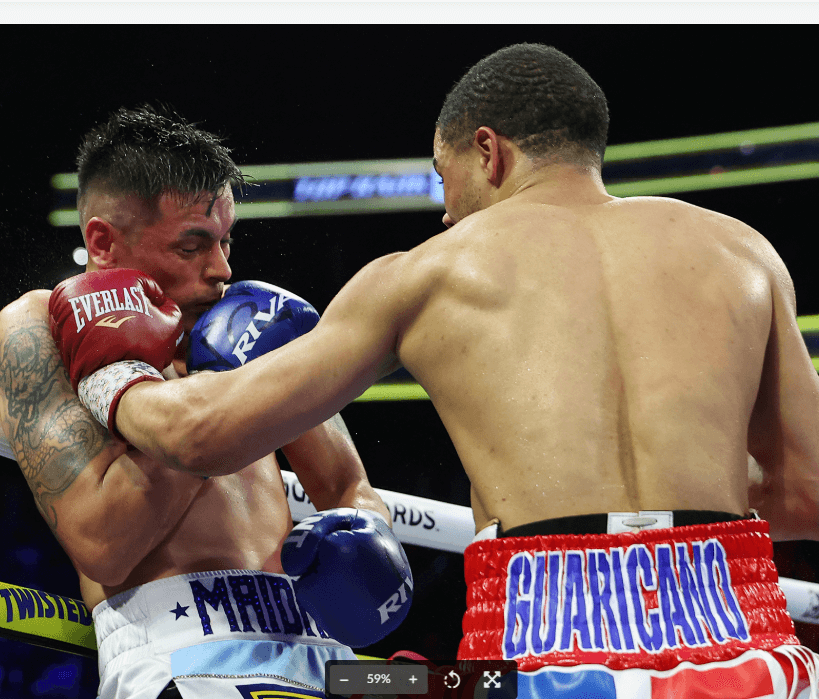
The curtain was drawn on a busy boxing weekend tonight at the T-Mobile Arena in Las Vegas where the featured attraction was Japanese superstar Naoya Inoue appearing in his twenty-fifth world title fight.
The top two fights (Inoue vs. Roman Cardenas for the unified 122-pound crown and Rafael Espinoza vs. Edward Vazquez for the WBO world featherweight diadem) aired on the main ESPN platform with the preliminaries streaming on ESPN+.
The finale of the preliminaries was a 10-rounder between welterweights Rohan Polanco and Fabian Maidana. A 2020/21 Olympian for the Dominican Republic, Polanco was a solid favorite and showed why by pitching a shutout, punctuating his triumph by knocking Maidana to his knees late in the final round with a hard punch to the pit of the stomach.
Polanco improved to 16-0 (10). Argentina’s Maidana, the younger brother of former world title-holder Marcos Maidana, fell to 24-4 while maintaining his distinction of never being stopped.
Emiliano Vargas, a rising force in the 140-pound division with the potential to become a crossover star, advanced to 14-0 (12 KOs) with a second-round stoppage Juan Leon. Vargas, who turned 21 last month, is the son of former U.S. Olympian Fernando Vargas who had big money fights with the likes of Felix Trinidad and Oscar De La Hoya. Emiliano knocked Leon down hard twice in round two – both the result of right-left combinations — before Robert Hoyle waived it off.
A 28-year-old Spaniard, Leon was 11-2-1 heading in.
In his U.S. debut, 29-year-old Japanese southpaw Mikito Nakano (13-0, 12 KOs) turned in an Inoue-like performance with a fourth-round stoppage of Puerto Rico’s Pedro Medina. Nakano, a featherweight, had Medina on the canvas five times before referee Harvey Dock waived it off at the 1:58 mark of round four. The shell-shocked Medina (16-2) came into the contest riding a 15-fight winning streak.
Lynwood, California junior middleweight Art Barrera Jr, a 19-year-old protégé of Robert Garcia, scored a sixth-round stoppage of Chicago’s Juan Carlos Guerra. There were no knockdowns, but the bout had turned sharply in Barrera’s favor when referee Thomas Taylor intervened. The official time was 1:15 of round six.
Barrera improved to 9-0 (7 KOs). The spunky but outclassed Guerra, who upset Nico Ali Walsh in his previous outing, declined to 6-2-1.
In the lid-lifter, a 10-round featherweight affair, Muskegon Michigan’s Ra’eese Aleem improved to 22-1 (12) with a unanimous decision over LA’s hard-trying Rudy Garcia (13-2-1). The judges had it 99-01, 98-92, and 97-93.
Aleem, 34, was making his second start since June of 2023 when he lost a split decision in Australia to Sam Goodman with a date with Naoya Inoue hanging in the balance.
Check back shortly for David Avila’s recaps of the two world title fights.
Photo credit: Mikey Williams / Top Rank
To comment on this story in the Fight Forum CLICK HERE
Featured Articles
Canelo Alvarez Upends Dancing Machine William Scull in Saudi Arabia
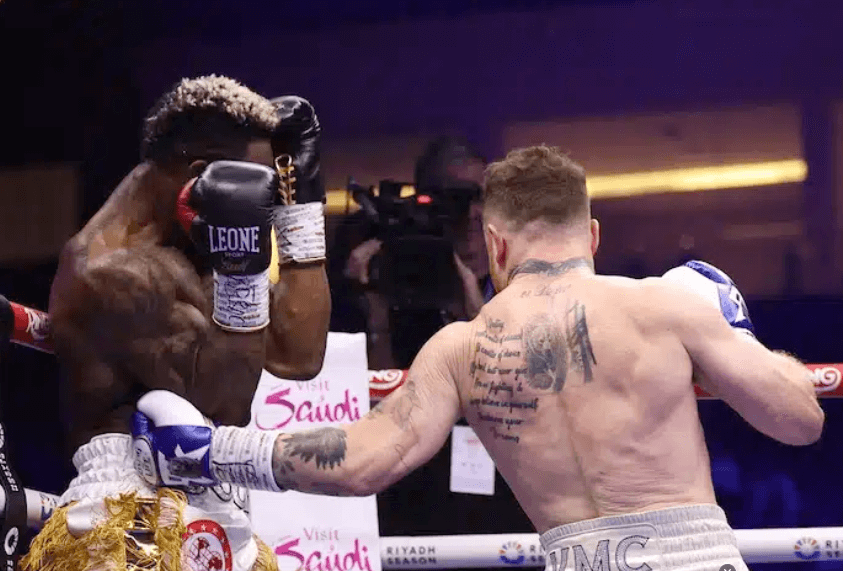
Saul “Canelo” Alvarez, who has acquired a new nickname – “The Face of Boxing” – is accustomed to fighting on Cinco De Mayo weekend, but this year was different. For the first time, Canelo was fighting outside the continent of North America and entering the ring at an awkward hour. His match with William Scull started at 6:30 on a Sunday morning in Riyadh.
In the opposite corner was 32-year-old William Scull, an undefeated (23-0) Cuban by way of Germany, whose performance was better suited to “Dancing With the Stars” than to a world title fight. Constantly bouncing from side to side but rarely letting his hands go, Scull frustrated Canelo who found it near-impossible to corner him, but one can’t win a fight solely on defense and the Mexican superstar was returned the rightful winner in a bout that was a fitting cap to a desultory two days of Saudi-promoted prizefighting. The scores were 115-113, 116-112, and 119-109. In winning, Canelo became a fully unified super middleweight champion twice over.
Terence Crawford was in attendance and HE Turki Alalshikh made it official: Crawford (41-0, 31 KOs) and Canelo (63-2-2, 39 KOs) will meet in the Fight of the Century (Alalshikh’s words) on Sept. 12 in Las Vegas at the home of the city’s NFL team, the Raiders. For whatever it’s worth, each of Canelo’s last seven fights has gone the full 12 rounds.
Semi-wind-up
In a match between the WBC world cruiserweight title-holder and the WBC world cruiserweight “champion in recess” (don’t ask), the former, Badou Jack, brought some clarity to the diadem by winning a narrow decision over Noel Mikaelian. One of the judges had it a draw (114-114), but the others gave the fight to “Jack the Ripper” by 115-113 scores.
A devout Muslim who is now a full-time resident of Saudi Arabia, the Sweden-born Jack, a three-division title-holder, had the crowd in his corner. Now 41 years old, he advanced his record to 29-3-3 (17). It was the first pro loss for Mikaelian (27-1), a Florida-based Armenian who was subbing for Ryan Rozicki.
The distracted CompuBox operator credited Mikaelian with throwing 300 more punches but there was no controversy.
Tijuana’s Jaime Munguia, a former junior middleweight title-holder, avenged his shocking loss to Bruno Sarace with a unanimous 12-round decision in their rematch. This was Munguia’s first fight with Eddy Reynoso in his corner. The scores were 117-111 and 116-112 twice.
Surace’s one-punch knockout of Munguia in mid-December in Tijuana was the runaway pick for the 2024 Upset of the Year. Heading in, Munguia was 44-1 with his lone defeat coming at the hands of Canelo Alvarez. Munguia had won every round against Surace before the roof fell in on him.
Surace won a few rounds tonight, but Munguia was the busier fighter and landed the cleaner shots. It was the first pro loss for Surace (26-1-2) and ended his 23-fight winning streak. The Frenchman hails for Marseilles.
Heavyweights
In a 10-round heavyweight match fought at a glacial pace, Martin Bakole (21-2-1) and Efe Ajagba (20-1-1) fought to a draw. One of the judges favored Ajagba 96-94 but he was outvoted by his cohorts who each had it 95-95.
Bakole, a 7/2 favorite, came in at 299 pounds, 15 more than he carried in his signature win over Jared Anderson, and looked sluggish. He was never able to effectively close off the ring against the elusive Ajagba who fought off his back foot and failed to build on his early lead.
The fight between the Scotch-Congolese campaigner Bakole and his Nigerian-American foe was informally contested for the heavyweight championship of Africa. That “title” remains vacant.
In a 6-rounder, heavy-handed Cuban light heavyweight Brayon Leon, a stablemate of Canelo Alvarez, was extended the distance for the first time while advancing his record to 7-0 at the expense of Mexico’s Aaron Roche (11-4-1). Leon knocked Roche to the canvas in the fourth round with a right-left combination, but the Mexican stayed the course while eating a lot of hard punches.
Photo credit: Leigh Dawney / Queensberry Promotions
To comment on this story in the Fight Forum CLICK HERE
-
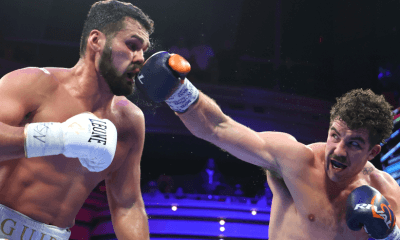
 Featured Articles4 weeks ago
Featured Articles4 weeks agoResults and Recaps from Las Vegas where Richard Torrez Jr Mauled Guido Vianello
-
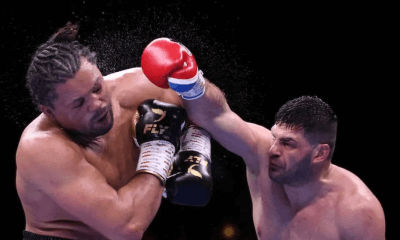
 Featured Articles4 weeks ago
Featured Articles4 weeks agoWeekend Recap and More with the Accent of Heavyweights
-
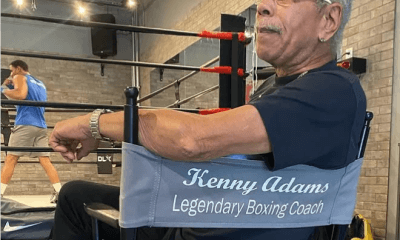
 Featured Articles4 weeks ago
Featured Articles4 weeks agoRemembering Hall of Fame Boxing Trainer Kenny Adams
-
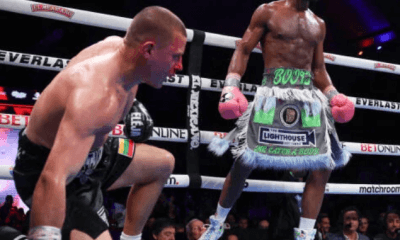
 Featured Articles3 weeks ago
Featured Articles3 weeks agoJaron ‘Boots’ Ennis Wins Welterweight Showdown in Atlantic City
-

 Featured Articles3 weeks ago
Featured Articles3 weeks agoBoxing Notes and Nuggets from Thomas Hauser
-
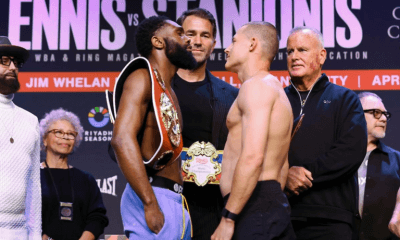
 Featured Articles3 weeks ago
Featured Articles3 weeks agoAvila Perspective Chap 320: Boots Ennis and Stanionis
-
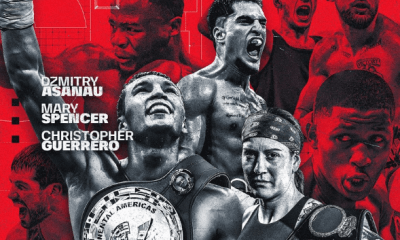
 Featured Articles4 weeks ago
Featured Articles4 weeks agoDzmitry Asanau Flummoxes Francesco Patera on a Ho-Hum Card in Montreal
-
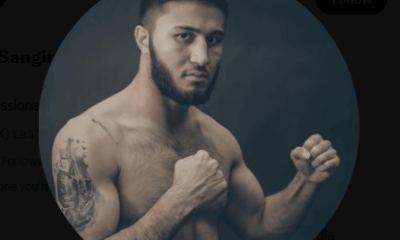
 Featured Articles3 weeks ago
Featured Articles3 weeks agoMekhrubon Sanginov, whose Heroism Nearly Proved Fatal, Returns on Saturday















